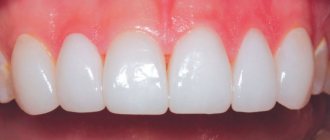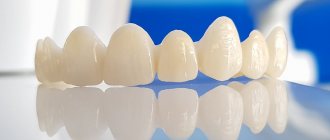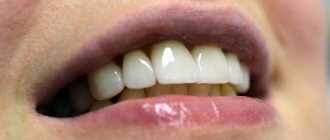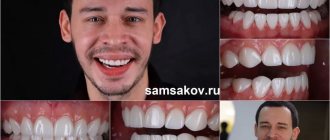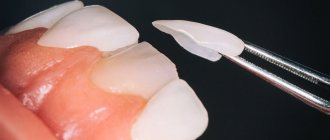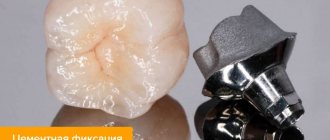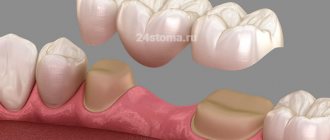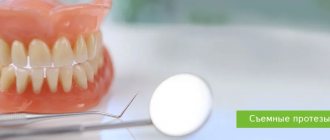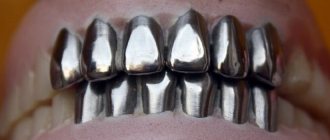A 25-year-old patient came to the clinic with a fairly popular, but, in her case, specific request to have a tooth extended. It was broken in childhood, but the patient found a broken piece, and kind dentists glued the piece back. According to the patient, he looked quite tolerable, although he was a little shorter than his neighbor, and he even tolerated orthodontic treatment well.
Treatment period is 3 weeks.
Price
| Feldspar veneer on a refractor | 45,000 rub. |
A patient came to the clinic with these teeth.
The reason for the patient’s visit to the clinic was that soon the composite material on which the previously chipped part of the tooth was glued became less aesthetically pleasing and stood out significantly in relation to the color of the dentition as a whole. This often happens with composite fillings, which are directly located in aesthetically important areas and often come into contact with coloring substances: coffee, tea, red wine, tomatoes. The difference in the length of the dentition has become more noticeable and noticeable over the years.
The picture shows a glued fragment of a broken tooth.
During the consultation survey, it was also found out that the adjacent central incisor also became darker than the lateral incisors for unknown reasons.
The patient was offered several alternative methods for restoring aesthetics, such as composite restoration and the popular, perhaps one of the most effective methods today - ceramic veneers on a refractor.
However, due to his young age and the presence of practically intact teeth (with the exception of a chipped tooth), it was decided to restore the shape and color of the two front teeth with ceramic veneers made of feldspathic ceramics, made on a refractory (fireproof) model.
Why are we the best in the ceramic veneers market?
- our doctors install more than a thousand veneers per year
- own dental laboratory
- we use only imported materials and medicines
- quality control at all stages of treatment
- absolute guarantee on design and work
- we offer veneers from economy class to premium highly artistic ones
- reviews from our patients are better than any words
- promotions and special offers allow you to save significantly
Call and make an appointment by phone 8-800-1000-234
Contraindications
Contraindications are the same as for conventional veneers:
- Bruxism – involuntary grinding of teeth during sleep;
- significant destruction of the crown of the tooth.
- significant bite defects;
- diseases of the teeth and gums (caries, pulpitis or periodontitis);
- tooth mobility;
What is the difference between composite veneers and ceramic refractor veneers?
Ceramic veneers on a refractor occupy a special position in dentistry due to their unique properties. Only ceramics, unlike composite and glass ionomer materials, have the best aesthetic effect. Composite veneers, even of the highest quality, are essentially plastic. Composite is a material consisting of several components that shrinks and changes color over time. Due to the properties of ceramics and the varied palette of colors used in the process of creating veneers, it is possible to achieve ideal accuracy in conveying the color and shape of the tooth.
Only with the help of ceramic veneers on a refractor can you achieve a natural shade and natural light transmission. All-ceramic veneers do not lose their natural shine, they are strong and durable, do not stain over time and retain their original shape and texture.
Manufacturing stages
The key differences between refractory veneers and conventional ones lie in the method of creating the plates. The main task of dental technicians is to make a ceramic plate that would most accurately convey all the features of the tooth on which it will be fixed in order to obtain a tight fit. Without meeting these conditions, the veneer cannot be reliably and efficiently installed on the tooth.
When creating virirs with a refractor, everything happens a little differently, although the initial stages of forming microprostheses are similar:
- An orthopedic doctor photographs the patient’s teeth and takes an impression of them. This is necessary for 3D modeling of a future smile;
- diagnostic wax-up - creating wax models for veneers so that the patient can try them on and evaluate the result. Also, fittings and wax models are needed so that the doctor receives the most accurate picture of existing dental defects; this is important to consider when creating veneers;
- if necessary, preparation, or grinding, of teeth, during which the doctor removes a minimum layer of tooth enamel. However, in some cases, when creating veneers using a refractor, you can do without preparation;
- if the teeth still undergo grinding, the doctor installs temporary veneers on them to protect the teeth from external influences;
- creation of permanent veneers - the formation of a fire-resistant base, followed by layer-by-layer application of ceramic mass and baking in an oven;
- Before fixing to the teeth, the finished veneers are etched and washed with a special solution to achieve a strong connection with the front surface of the tooth;
- installation of permanent veneers using dental cement.
Installing veneers is a lengthy process that requires patience and several visits to the clinic. The production of plates alone in a dental laboratory takes from 1 to 3 weeks. Accordingly, the entire process from the first visit to an orthopedic dentist to the fixation of finished veneers can take about a month.
Can a ceramic veneer made with a refractor crack or break?
After manufacturing, ceramic veneers on the refractor are a thin plate. It looks like a translucent scale of a given color.
Of course, if the veneer is dropped or hit with a heavy object, it will crack and break. But, as soon as the doctor attaches this thin plate to the tooth with a special photopolymer composition, the veneer and tooth form a strong, monolithic connection. According to its technical characteristics, a ceramic veneer on a refractor is harder than tooth enamel. The use of veneers does not require any special conditions. The only restriction is not to test their strength and not to crack nuts with your teeth, not to chew through the wire and not to open bottles. Heavy loads can lead to chipping of your own tooth and detachment, compromising the integrity of the ceramic veneer.
Achievements of modern dentistry
Previously, massive plates were installed that required the removal of part of the tooth. Now the veneer is an ultra-thin (up to 0.4 mm) ceramic plate. Such thin structures are made of durable ceramic materials. Even the thinnest veneer can withstand serious loads.
Veneers are considered an aesthetic area of dentistry, due to their main function - changing the shade and shape of the tooth. There is also a functional significance. Ceramic coating allows you to hide visual enamel defects, eliminate interdental spaces, and hide pigmentation. In addition, veneer performs a protective function - ceramics are resistant to abrasion, which cannot be said about natural enamel. Ceramics do not retain plaque and pathogens.
Can teeth be treated after installing ceramic veneers?
Before installing ceramic veneers, the doctor must examine the patient’s oral cavity and carry out the necessary procedures: treats caries, removes plaque, whitens teeth. If caries subsequently occurs on the tooth with the veneer installed, treatment is carried out and a filling is installed. Also, after installing ceramic veneers, in order to extend the life of the plates, it is necessary to regularly carry out professional comprehensive cleaning of the oral cavity.
Ceramic veneers – what are they?
A ceramic veneer is a thin plate of particularly durable ceramic less than 1 mm thick – from 0.3 to 0.5 millimeters. In essence, it is a microprosthesis that is located on the outer, visible part of the tooth and is fixed with dental cement. With the help of veneers, you can change the color and shape of teeth, close tremata and diastemas, and correct mild crooked and crowded teeth.
Can a composite veneer lose its shine and delaminate?
Although veneers made from composite materials are usually cheaper, in all other respects they are significantly inferior to ceramic veneers.
Ceramic veneers are the best solution for creating a perfect smile. And composite material is essentially plastic, even expensive, even of high quality. Over time, it loses its original appearance - it loses its shine, darkens and even flakes.
Ceramics is much stronger, plus it is bioinert, that is, it does not enter into any chemical reactions with its environment. Therefore, ceramic veneers do not change the original color, do not lose their shape, and retain the natural relief and transparency of natural teeth. These qualities make ceramic an excellent material for creating the perfect smile.
The disadvantages of veneers
, perhaps, can be attributed:
- high cost of ceramic veneers. The average price in Moscow for 1 well-made and installed ceramic veneer starts from 000 rubles. In Premium class clinics, the cost of a veneer starts from 40,000 rubles for 1 veneer.
- difficulty in installing ceramic veneers. Installation involves several stages, including wearing temporary veneers.
Therefore, if you want to get high quality that will stay with you for life, choose a clinic and specialist who have the appropriate qualifications and are able to guarantee the longevity of their work.
The difference between ceramic veneers and lumineers
Is it possible to obtain high-quality dental restoration using lumineers? My personal opinion is no.
Lumineers are also thin coverings on teeth used in aesthetic dentistry. They are usually thinner than porcelain veneers, but are more matte and less able to convey the transparency and shine of the enamel. It is believed that tooth grinding is not necessary to install lumineers - this is a misconception. Because if you glue a lumineer onto an untreated tooth, the tooth will become larger and will look unnatural.
Therefore, for high-quality dental restoration, it is preferable to use ceramic veneers.
Metal-free ceramics
Metal-free ceramics have recently revolutionized dental prosthetics and aesthetic dentistry. Using this technology, crowns, veneers and inlays are made, which not only have high aesthetic qualities, but are also not inferior in strength to metal-ceramic structures. More and more dentists are inclined to believe that metal-free ceramics will soon replace metal-ceramic technologies, due to the fact that it can solve the most complex cases of necessary restoration and dental prosthetics.
Advantages of ceramic crowns
- Excellent aesthetic result. Metal-free ceramics have an ideal light reflection effect identical to the enamel of a living tooth, which is especially important when restoring anterior teeth.
- A dark stripe does not form at the border of the gum and crown, as occurs with prosthetics with metal-ceramic structures. Actually, this strip occurs when the gums come into contact with metal.
- High structural strength. All-ceramic crowns are more firmly attached to the tooth tissue than metal-ceramics, since they are attached to the tooth not due to mechanics, but also due to chemical reactions. The connections between inlays and veneers are also highly durable.
- High biocompatibility. Ceramics is an inert material that does not corrode and does not cause rejection reactions or allergies, which is especially important for patients with galvanism, periodontitis and allergic reactions to metals.
- Minimal preparation and grinding of the tooth is required during installation. In some cases, the tooth is not prepared at all.
- Due to the absence of metal inserts, the design is lightweight and does not exert strong mechanical pressure on the gum tissue.
- All-ceramic crowns have elasticity similar to natural enamel. This contributes to the absence of discomfort during chewing and eating.
- They provide an ideal marginal fit, which prevents the development of inflammation and caries.
- They are distinguished by durability in use and preservation of their original aesthetic properties for many years.
- Easy to maintain - no plaque forms on the ceramic surface.
Types of metal-free ceramics
Ceramics is a solid substance of inorganic and non-metallic nature, obtained by heating to high temperatures and subsequent cooling.
Dental ceramics contain metal oxides, carbides, nitrites and other components and their combinations.
The dental classification of these materials is based on an integrated approach, including a special composition and method of processing the material to obtain the finished product. The ART clinic uses techniques.
Metal-free ceramics on a refractor
Metal-free ceramics on a refractor are prosthetic structures in the form of the thinnest all-ceramic plates, veneers or, as they are also called, lumineers. Veneers on refractors are used to eliminate relatively minor defects in the tooth crown:
- chips;
- enamel cracks;
- diastema;
- violation of enamel shade.
Based on an individual impression, thin all-ceramic plates are made, which are fixed with a special glue on the front surface of the tooth.
Advantages of this technology:
- Minimal preparation of natural crowns. To install all-ceramic veneers, it is enough to grind the tooth thinner than 0.3 mm, or in some cases not grind at all.
- Strong fixation. Thin veneer plates, when fixed to a tooth, form a strong monolithic, almost indestructible structure.
- Strengthens the strength of natural crowns - there are no additional restrictions after prosthetics. The teeth are ready to be used for their intended purpose in full.
Pressed ceramics or metal-free ceramics E MAX
Pressed metal-free ceramics E MAX is a new generation material whose microstructure is based on a glass matrix surrounding lithium disilicate crystals. In other words, it is glass ceramics, which through special processing achieves the required strength parameters.
E max ceramics are mainly used for the production of veneers and inlays, but can also be used for the production of solid single crowns for teeth that do not bear a large chewing load.
Ceramic crowns based on aluminum oxide and zirconium
These materials are highly durable, so they are recommended for the restoration of teeth that bear a high chewing load. In terms of aesthetic properties, they are not inferior to pressed ceramics.
These materials are mainly used to make dental crowns. Aluminum oxide has a slightly different appearance from natural enamel - aluminum oxide crowns are not installed on the front teeth. Zirconium oxide is characterized by better aesthetic parameters, which is why it is now used.
In addition, to improve the appearance of the crown, ceramic masses can be applied over a zirconium or aluminum oxide cap, which will be identical in appearance to living teeth.
Thus, metal-free ceramics will eliminate such shortcomings as discoloration of the enamel, darkening of extensive fillings, and chips on the front teeth. We successfully use all-ceramic crowns for dental prosthetics; we use them both for the manufacture of bridges and for implantation. In any case, we are ready to help you choose the optimal method for solving your problems, both in terms of aesthetic results and in terms of restoring functional activity.
As an example of the use of metal-free ceramics on the front teeth, we invite you to evaluate the before and after photos.
